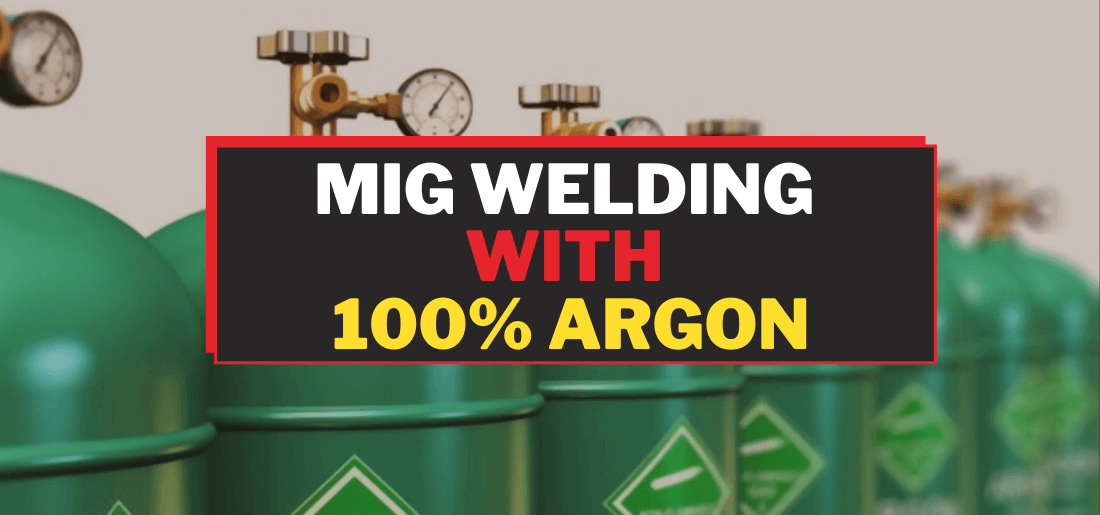Are you wondering if you can use 100% argon for MIG weld mild steel? If yes, then we can tell you when and how you can use this inert gas for MIG welding.
Do you know in order to prevent the weld pool from harmful contamination, welding industries use argon as a shielding gas?
Although, you might not know that this gas does more than welding beads when you decide to use pure argon. So, you have to understand that this welding gas comes with many pros and cons. There are many cases where you have to use 100% argon, but you also have to pay the price.
To answer your question, we will tell you all the possibilities regarding the use of pure argon for MIG weld mild steel. While reading this article, you will know why and when people consider using 100% argon. Now, without further ado, let’s get started!
What is MIG Welding?
MIG welding is the simplest form of welding. It’s famous for being cost-effective, fast and can be modified easily according to specific projects. This type of welding processes as an arc joint in which a solid wire electrode is passed on to the welding gun. Then from there, it goes to the weld pool and joins the two materials.
Usually, you can use 100% argon for MIG weld mild steel, but it does have some effects. To know why it happens and how you can use argon with mild steel, you must fully understand the whole process.
Here we will discuss everything to let you know that you can use pure argon or not.
Can You Use Pure Argon for MIG Weld Mild Steel?
Generally, it’s a hobby of any welder to keep a bottle of pure argon and other gases while doing any welding project. If the bottle of MIG gas run out, you will not know how long it will last.
You can use 100% argon for mild steel, but it might result in brittle, weak and unappealing welded joints. It also reduces the chances of thermal conductivity for fluid present in a weld pool on ferrous metals.
Moreover, the outer lining remains cold, which results in narrow and tall perforation with less fusion. Also, an undermining disruption weakens the welding. When you use an argon shielding gas, then the MIG welding loses its pliability that causes brittleness.
When Can You Use 100% Argon?
Most people want to know when you should consider using argon for MIG welding. You can use it when you forget to bring your gas bottle, and you have time to get back to the workshop for getting more gas.
That’s the time when you can use pure argon to save your time and get the work done. There will be no interruption, and you also don’t have to refill your MIG mixture bottle. You are just resourceful and productive when you use pure gas in this type of situation.
Although the mild steel might not come out in high quality, it also depends on what you use for welding. There are some scenarios when you can use 100% argon to MIG weld steel:
- You can use it when the appearance of welding is not the priority.
- Brittle weld beads should not become the cause of trouble for anyone.
- If the welding fails, then it doesn’t hurt anyone.
Outcomes OF Using Pure Shielding Gas
The shielding gas can cause damage if it stays in the weld pool for long as it can make the weld permeable. You need to know the outcome when you use 100% argon for MIG weld mild steel.
Following are some characteristics of shielding gas you might experience while using it:
- Due to the low ionization capability of Argon, the voltage and power of an arc decreases. That makes the arc unstable.
- When you join an unstable arc, then fluid doesn’t come into the pool. Ultimately, it will be rigid, and you will not be able to work on metal.
- The filler material remains on the top of steel in the shape of a tall and narrow bead.
- By using pure argon, the MIG welds are prone to weaken.
- Lack of ductility results in cracking and breaking of stiff welds.
Although, you can use the shielding gas to join the steel together, but you will end up with stiff, weak and bad-looking welding beads. If you are going for solid and quality work, then you can’t use 100% argon to weld mild steel.
Tips of Using 100% Argon
If you end up in a difficult situation where you must use the shielding gas for MIG weld mild steel, then consider the following tips:
- Tilt the weld bead’s borders to help the infusion of base metals and ultimately give you a strong joint.
- Make sure the turn up the heat level, but don’t overdo it. The heat should not burn the inner steel while making the bead flat on top of steel.
However, when you use 100% argon with different base metals, you can get good results. The base metals you can use are:
- Magnesium
- Titanium
- Aluminium
- Copper
- Nickel
There is also an interesting fact for some welders as when you MIG weld a steel sheet, then argon’s lower penetration is beneficial for many.
Does Argon Work Better When Blends With CO2?
If you blend a little amount of carbon dioxide in 100% argon, then it can give better welding results for MIG weld steel. You can add 5 to 25% of CO2 in argon so that you won’t have tall and narrow welding joints in MIG welding
Moreover, this blend provides fluid in the weld pool that gives better perforation. It reduces the chances of inner disruption, and there will be less spatter. Most importantly, the cooling and heating of edges are under controlled, so the mild steel won’t break easily.
Furthermore, when you buy the mixture bottle of argon and carbon dioxide, then the gas is already labelled with a specific amount of CO2 in it. If it is written as C25, then it means that the mixture contains 25% CO2 and 75% argon.
Why 100% Argon Is Better For TIG But Not For MIG Welding?
Both TIG and MIG welding are different when it comes to their filler material and type of electrode. That also affects the arc and outcomes of weld joints. You know that MIG welding uses the wire as an electrode that later consumed.
However, TIG welding uses a tungsten electrode that is not consumable, and the filler is passed on to the arc individually. By doing that, you can get a solid and stable angle when also ensures that the tungsten tip is clean and undamaged.
Besides, it uses a gas that remains inert even when the heat is extremely high. So, TIG welding uses argon to produce a stable arc, and it also keeps the tip of the electrode unharmed. We can conclude that 100% argon works for TIG welding and the blend of argon and CO2 is beneficial for MIG welding.
FAQs about Pure Usage of Argon
Q-1: Why would you use pure argon?
Pure argon is used in a time of necessity. When you run out of gas or your gas supplier is closed, then you have to use the pure argon to get the welding done. Although, it might result in a shoddy looking weld beads.
Q-2: Why does 100% Work to TIG weld steel?
It works well with TIG because this type of welding uses a tungsten electrode, and is fed on the weld pool separately. That results in the stable and robust arc of weld joints. Also, argon keeps the tip of the electrode clean.
Q-3: Is Argon an expensive gas?
Yes, it’s an expensive gas. Argon is an inert gas and can’t react quickly with any other substance that makes it rare. Also, it has a small percentage in the atmosphere, which makes it more expensive than nitrogen.
Q-4: What is the best percentage for blending CO2 and argon?
Welding industries who want a better weld quality, appearance, and post clean up prefer the mixture of 75-95% argon with 5-25% CO2. It’s the best possible mixture of two gases to provide a stable arc, less spatter and desirable control.
Final Words
Now, you know you can use 100% argon for MIG weld mild steel or not. There are many cases when you have to use pure argon, but at the same time, you have to be prepared for the outcomes. The brittleness makes the inner steel so weak, and it ends up cracking when you try to mould it.
Moreover, if you don’t care about weld joints’ appearance, you can follow the tips of using pure argon to complete the task. Besides, when you mix some amount of CO2 with argon, then you can sure get your desired results.
I hope this article served its purpose by providing you with the required information about the usage of 100% argon for MIG weld!
Related Articles:




